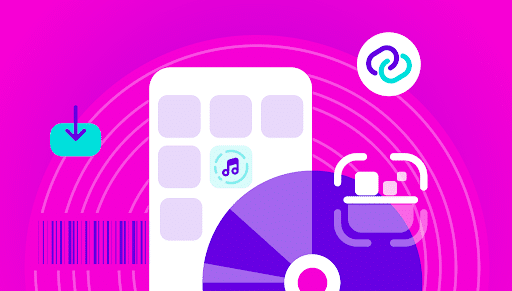This past August, the music industry celebrated the 50th anniversary of Bruce Springsteen’s breakthrough album “Born to Run.” For many fans, especially those who remember the record’s release, this milestone may be sobering. Fifty years in any context is a loooong time. But if the Boss is still rocking with new songs and sold-out venues — not to mention a biographical musical drama film starring Jeremy Allen White coming out tomorrow — you can look back fondly and draw some interesting parallels between the evolution of music delivery and brand-connecting strategies.
From vinyl records and cassettes to CDs, MP3s, and streaming, the way we listen to music has dramatically changed. The same is true of linking and user experiences, as brands have gone from barcodes and QR codes to the further exploration of QR codes and deep linking — all in an effort to make mobile life easier and content more accessible.
So, let’s take a trip down memory lane with some “deep cuts” into the historical milestones or connections between music formats and linking innovations.
Milestone 1: Barcodes and vinyl records (1950s–1970s)
If you’re of a certain age, vinyl records bring back nostalgic memories of cool covers, delicate handling, and much-anticipated double-album releases. First introduced in the 1930s, vinyl didn’t really take off until Columbia Records issued the iconic 331/3 rpm LP (long play) in 1948. Shortly thereafter, everyone was buying and collecting record albums as they became the standard for audiophiles for decades to come. Certainly, when “Born to Run” came out, albums were at their peak popularity.
Barcodes followed a similar trajectory. First invented in the ‘40s as a way for supermarkets to more easily read product information at checkout, barcodes didn’t really gain traction until the mid-70s (not too far behind the release of Bruce’s masterpiece). That’s when an IBM engineer developed the Universal Product Code (UPC), which opened the door for mass scanning and quicker checkouts at retailers the world over. For consumers, this meant a better overall user experience with not just their local Safeway or Kroger, but the brands they brought home.
Like vinyl, barcodes weren’t flawless, but they became the first truly universal format in their space. Both laid the foundation for everything that came next.
Milestone 2: QR codes and cassettes/CDs (1980s–2000)
For Gen Xers, the portable cassette tape was most likely their first preferred way to listen to music. Portable, resilient, and recordable cassettes were first introduced by Philips in the early ‘60s and really took off in the ‘70s and ‘80s. They didn’t replace vinyl (old habits die hard) but provided a more convenient alternative, especially in the car and with the advent of Sony’s Walkman in 1979.
Real change came in the late ‘80s and extended well into the ‘90s with the launch of the compact disc, or CD. Digital, with higher fidelity, and certainly more durable than vinyl, CDs became the global music standard with billions sold annually. To millennials or Gen Y, this is probably your earliest recollection of listening to Britney Spears or Green Day at home or in the car.
Meanwhile, on the linking front, engineers at Denso Wave (a Toyota subsidiary) created the QR (Quick Response) code in 1994 to track auto parts on fast-moving assembly lines. Its two-dimensional grid could hold hundreds of times more data than a barcode, and it could be scanned from any angle. Shortly thereafter, other brands adopted the design and used it freely.
Like cassettes and CDs, QR codes gradually made their way to the consumer. By the early 2000s, they were appearing in brand ads and packaging, as well as public transit systems. But the experience wasn’t seamless yet, as early mobile phones needed third-party scanner apps, and cameras often struggled to capture codes. Scanning a QR in 2005 could feel as clunky as rewinding a cassette with a pencil. Not the best UX.
Milestone 3: Transitional era with QR experimentation and MP3s (2000s)
Even as CDs dominated, the seeds of disruption were already planted. First developed in 1991 by Germany’s Fraunhofer Institute, the MP3 shrank songs from bulky 30-40 MB files down to just a few megabytes, making them small enough to share, store, and carry.
What soon followed was the emergence of Napster in 1999, a platform that saw 80 million users downloading and swapping MP3s, right before lawsuits shut it down. Then Apple’s iPod came along and promised “1,000 songs in your pocket,” making MP3s a legitimate, mainstream format. In 2003, Apple launched iTunes, giving MP3s further legitimacy while also more or less signaling the steady decline of CDs.
MP3s weren’t perfect. They were fragmented, pirated, and clunky to manage, but they reshaped expectations. People wanted immediacy and portability, even if the experience wasn’t ideal just yet.
Concurrently, QR codes were on their own experimental journey. For years, they lingered as a curiosity, but rarely delivered a smooth experience. That started to change in the 2010s. Native camera scanning replaced the need for third-party apps, and cameras became sharper and faster. Marketers also embraced dynamic QR codes that didn’t just point to a fixed URL, but instead redirected through a server. This meant the destination could be updated and scans tracked, paving the way for deeper analytics and more intuitive user journeys. Brands also began customizing QR codes with logos and creative designs, making them more visible, consistent, and engaging.
While MP3 players and iTunes reinvented our relationship with music over several years, it was actually the COVID-19 pandemic that gave the QR code its long-overdue “mainstream moment.” In 2020, with so many people sheltering or social distancing, QR codes were suddenly everywhere, from digital menus at restaurants and touchless event check-ins to vaccine passports and even Super Bowl ads. In the U.S. alone, QR usage spiked from 52.6 million in 2019 to 83.4 million in 2022, and it’s expected to reach nearly 100 million in 2025.
Milestone 4: Deep linking and streaming (2014–2015 → today)
Once the MP3 era showed everyone what was possible, music evolved again to become truly seamless. Streaming eliminates the friction of downloads, storage limits, and messy file transfers. Platforms like Spotify (2008) and Apple Music (2015) normalized streaming as the only way to listen to your favorite artists. By 2016, streaming had become the dominant format in U.S. music with 22.6 million paid subscriptions, generating more revenue than downloads or physical media sales for the first time. (Yet, surprisingly, albums are enjoying a resurgence, as major artists — yes, Bruce Springsteen himself — drive a “back-to-the-future” release of vinyl, cassettes, and even CDs.)
Streaming certainly wasn’t a new idea or demand. The technology just finally caught up to consumer expectations. And if QR codes were the MP3 in connecting with brands, deep links are the streaming equivalent.
As mobile apps quickly emerged as the preferred option for brand engagement, a problem also surfaced: the dreaded broken link. Tapping a link often dropped users on a homepage instead of the specific product, video, or article they expected. If the app wasn’t installed, the journey usually ended in frustration.
Emerging in the mid-2010s and popularized about the time of Apple Music’s launch, deep links allowed marketers and developers to send users directly to the right in-app destination. With deferred deep linking, even if the app wasn’t installed, the link carried the user through the install process and then delivered them to the intended content.
For marketers, this breakthrough was transformative:
- Acquisition campaigns no longer led to broken journeys.
- Reengagement campaigns could bring users back exactly where they left off.
- Attribution became clearer, tying clicks to outcomes across platforms.
Essentially, deep links removed any and all friction. To equate this with corresponding music innovations, this meant no skipping tracks, no rewinding, no slow downloads; just instant access to the right content.
The common thread: Reducing friction
When you step back and look at the evolution of music formats and linking technologies, a clear theme emerges. Every significant milestone was about removing barriers. Vinyl records made music repeatable at home. Barcodes allowed retailers to scan and process goods at scale. Cassettes and CDs gave listeners portability, just as QR codes enabled brands to embed richer content. And streaming, much like deep linking, made technology almost invisible.
Each new and improved “format” fundamentally changed the relationship between consumers and the content they were trying to access. Music listeners stopped worrying about scratches or rewinds. Mobile users stopped worrying about dead links or broken app journeys. The less friction there was, the more natural the experience became, until the medium itself faded into the background. Seamlessness became the expectation, not the exception.
What’s next? The future of music and linking
Streaming may dominate today, but music formats haven’t stopped evolving. Spatial audio, AI-curated playlists, and immersive listening are already redefining how people experience songs. The track may be the same, but the delivery keeps adapting to new contexts and new consumer demands.
Links are on a similar path. QR codes now trigger dynamic deep links that adapt to devices, apps, and user states. Tomorrow, links may live in AR and VR environments, activated by simple, subtle gestures. Voice assistants could replace clicks, turning “links” into spoken commands. And as privacy rules tighten, new formats will emerge that preserve personalization while respecting user control.
The trajectory seems clear: We’re constantly moving toward more seamless experiences. Just as no one asks whether they’re listening to a CD or a stream, brand customers won’t ask whether they clicked a link, scanned a code, or spoke a command. They’ll simply get to where they want to go.
The playlist of connection
The history of music formats shows us that people will always choose the path of least resistance. The same is true for linking. Barcodes, QR codes, and deep links weren’t just incremental upgrades. They were significant leaps forward that reshaped user expectations and how they engaged with brands.
Today, deep linking is the streaming era of connection. It’s seamless, invisible, and just works. And just like streaming has made it possible to measure listening habits and tailor recommendations, deep linking gives brands the ability to understand, personalize, and improve the journeys their valued customers take. That should be music to everyone’s ears.
Want to see how deep linking can reduce friction in your customer experience? Reach out and start building your seamless journey today.




